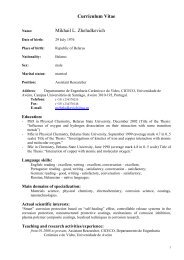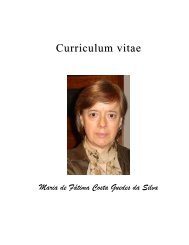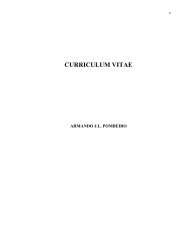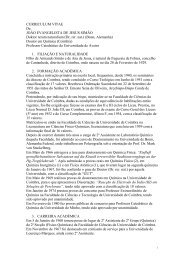XII Iberian Meeting of Electrochemistry XVI Meeting of the ...
XII Iberian Meeting of Electrochemistry XVI Meeting of the ...
XII Iberian Meeting of Electrochemistry XVI Meeting of the ...
Create successful ePaper yourself
Turn your PDF publications into a flip-book with our unique Google optimized e-Paper software.
<strong>XII</strong> <strong>Iberian</strong> <strong>Meeting</strong> <strong>of</strong> <strong>Electrochemistry</strong> & <strong>XVI</strong> <strong>Meeting</strong> <strong>of</strong> <strong>the</strong> Portuguese Electrochemical Society PD 06<br />
Corrosion behaviour <strong>of</strong> quaternary bronzes in slightly<br />
passivating environments<br />
Mariano Pérez, Maurizia Calvisi, Gemma Mª. González-Mesa<br />
Departamento de Química Física. Universidad de La Laguna. Tenerife. España<br />
mjperez@ull.es<br />
This communication show <strong>the</strong> first results <strong>of</strong> a work on corrosion/protection<br />
<strong>of</strong> bronze materials. This work has been developed from <strong>the</strong> factory ingots (first<br />
foundry) <strong>of</strong> quaternary bronze materials and from <strong>the</strong> so called chimney residuals<br />
resulting from a second cast bronze materials used for filling <strong>the</strong> sculpture molds.<br />
The deviation <strong>of</strong> compositions and crystalline structure <strong>of</strong> both first and second foundry<br />
bronzes have been studied by SEM/EDS and DRX and compared to <strong>the</strong> ingots factory<br />
specifications.<br />
Metal samples shaped as planar disks, as received from <strong>the</strong> factory (EB), were<br />
kept in natural atmosphere, not specially corrosive (indoors), for 10-12 months. Then<br />
<strong>the</strong>y were characterized by SEM-EDX, noticing <strong>the</strong> topographic and composition<br />
variations due to this oxidation period respect to <strong>the</strong>ir initial status.<br />
Following <strong>the</strong> results <strong>of</strong> <strong>the</strong> previous observations <strong>the</strong> redox characterization<br />
<strong>of</strong> <strong>the</strong>se materials were carried out with <strong>the</strong> abovementioned shaped disk samples as<br />
working electrodes, by cyclic voltammetry in a slightly passivating environment,<br />
aqueous sodium tetraborate solution (pH 9.3), to detect components peaks in <strong>the</strong> records<br />
made and trying to assign <strong>the</strong>m to redox couples <strong>of</strong> <strong>the</strong> metal components <strong>of</strong> <strong>the</strong>se<br />
alloys.<br />
In parallel, <strong>the</strong> same type <strong>of</strong> voltammetric records were carried out with metal<br />
samples <strong>of</strong> <strong>the</strong> main alloy components, that is, <strong>the</strong> components <strong>of</strong> <strong>the</strong> studied quaternary<br />
bronze alloys, namely, copper, tin, zinc and lead.<br />
Correlation <strong>of</strong> redox characteristics and corrosion behaviour versus <strong>the</strong><br />
crystalline structure <strong>of</strong> <strong>the</strong>se quaternary alloys are attempted [1].<br />
Acknowledgments: enterprise and materials<br />
supplier.2.SEM/EDS and XRD SEGAI Services from ULL. 3 Pr<strong>of</strong>. L. Galindo. Depto. Quimica<br />
Analítica. ULL.<br />
References<br />
[1] <br />
September, 811, 2010. ISEL - Lisbon 88








